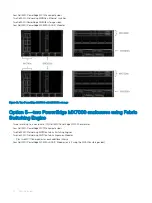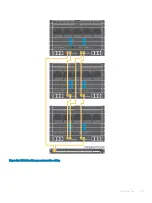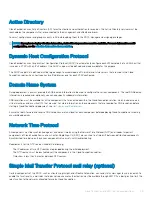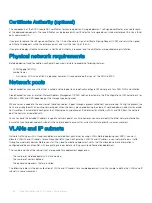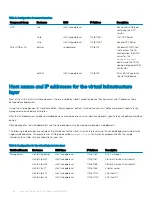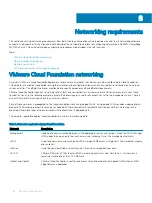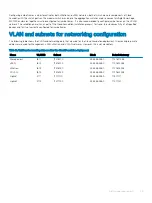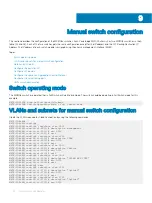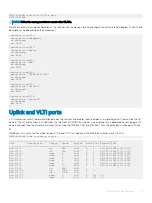
Networking requirements
This section covers the networking requirements from both the Cloud Foundation software perspective and from a networking hardware
connectivity perspective. This section also briefly describes the configuration options for configuring networks on a Dell EMC PowerEdge
MX7000 chassis. The actual networking configuration procedures are described in the later sections.
Topics:
•
VMware Cloud Foundation networking
•
•
•
VLAN and subnets for networking configuration
VMware Cloud Foundation networking
A successful VMware Cloud Foundation deployment relies heavily on networks that are constructed and allocated to Cloud Foundation.
The networks are used by Cloud Builder during the installation and configuration process and then used by Cloud Foundation to carry out
various activities. The different networks are allocated to specific purposes and have different requirements.
VMware Cloud Foundation requires six networks and at least one connection to a customer network (for external access to your Cloud
Foundation stack). In the following example, a private IP address range is used for all connectivity within the management stack. There is
also an IP network that connects back to an external network.
Each of these networks is propagated to the Cloud Foundation stack using tagged VLANs. Using tagged VLANs enables mapping of port
groups to VLANs allowing access to resources as needed. All these networks are routable to and from each other. The routing task is
executed at some layer above the access level switched fabric that is deployed here.
The networks required to deploy Cloud Foundation are listed in the following table:
Table 9. Networks required to deploy Cloud Foundation
Network
Description
Management
Dedicated to communication between all the deployed resources and services. When the SDDC Manager
Utility needs to communicate to any other service or resource, it uses the management network.
vSAN
Used to communicate and synchronize vSAN storage traffic across multiple hosts to ensure data integrity
and resiliency.
vMotion
Used to quickly redistribute virtual machine state and or storage between hosts.
VXLAN
VMware NSX uses VXLAN to extend NSX networking constructs from host to host. This network is
sometimes referred to as the VTEP Network.
Uplink 1 and Uplink 2
VMware Cloud Foundation uses these networks for northbound and southbound traffic when an NSX
Edge Gateway is deployed.
8
38
Networking requirements
Содержание PowerEdge MX7000
Страница 1: ...Dell EMC VMware Cloud Foundation for PowerEdge MX7000 Deployment Guide ...
Страница 8: ...Figure 1 Cloud Foundation deployment workflow 8 Overview ...
Страница 27: ...Figure 19 Dual PowerEdge MX7000 enclosure configuration Physical layout 27 ...
Страница 29: ...Figure 20 MX9002m Management module cabling Physical layout 29 ...
Страница 30: ...Figure 21 Connectivity between FSE modules and FEM modules 30 Physical layout ...
Страница 31: ...Figure 22 Uplinks to customer network environment Physical layout 31 ...
Страница 42: ...Figure 25 MX9002m Management Module cabling 42 Networking requirements ...
Страница 43: ...Figure 26 Connectivity between FSE modules and FEM modules Networking requirements 43 ...
Страница 44: ...Figure 27 Uplinks to customer network environment 44 Networking requirements ...

